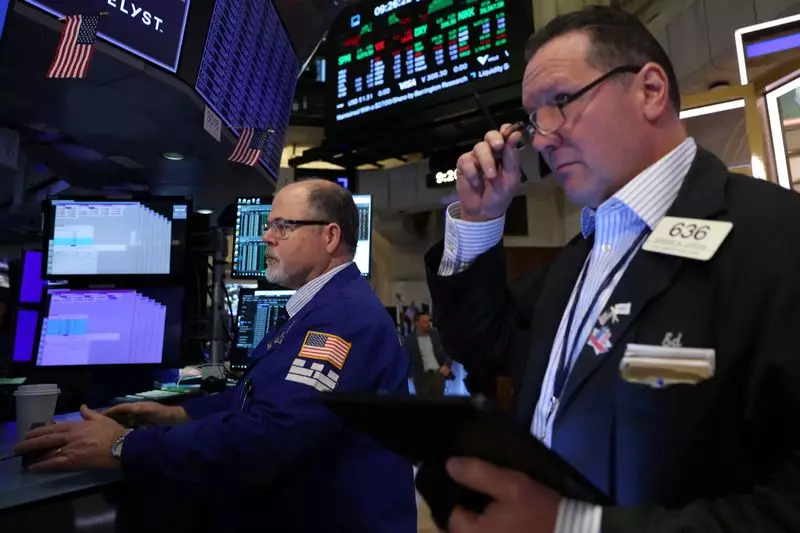As the financial world reacted to the latest developments from Washington, investors were welcomed by a bullish trend across Wall Street. On a notable Tuesday, both the S&P 500 and the Dow Jones Industrial Average climed to heights not seen in over a month. The optimism primarily stemmed from President Donald Trump’s early policy decisions during his second term, particularly regarding the tariff discourse that had previously fueled uncertainty in the global markets. This article delves into the subtle nuances of the market’s reception, broader implications for trade policy, and the crucial dynamics that investors must navigate in these turbulent economic times.
In his first executive actions, President Trump notably refrained from implementing the sweeping tariffs he had previously threatened against multiple countries. Instead, he hinted at reviewing tariffs specifically on Canadian and Mexican goods, with a possible announcement expected shortly. Investors appeared relieved that the anticipated ‘blanket’ tariffs were not immediately enacted. According to BMO Private Wealth’s Chief Market Strategist, Carol Schleif, this absence of punitive trade policies startled the market in a positively surprising manner. The notion of a more tactical approach to tariff negotiations engendered a sense of stability among traders, who’ve had to brace for economic tumult resulting from aggressive trade policies in the past.
The market remains cautiously optimistic, with financial giants like Goldman Sachs even adjusting their forecasts downwards regarding the implementation likelihood of universal tariffs from 40% to a mere 25%. This reflects a growing belief that the Trump administration might favor negotiation strategies over hardline tariffs, signaling potentially favorable outcomes for industries sensitive to international trade.
Last week, the prevailing mood in the market shifted drastically. Following significant gains in bank earnings combined with signs of cooling inflation, the S&P 500 and Dow achieved their largest weekly percentage increases since November. With a revival of confidence, the small-cap Russell 2000 index managed to outperform larger-cap indexes by registering a notable 1.7% increase. This rally is notable, as it illustrates the extent to which domestic-focused firms are benefiting from an environment that prioritizes localized economic growth amidst a backdrop of uncertainty.
As of the afternoon trading session, the Dow reflected a healthy increase of 466.30 points, translating to a rise of 1.07%. The S&P 500 followed suit with a gain of 52.48 points, achieving a total of 6,049.14. This gathering momentum underscores the significance of investors’ reactions to policy changes and their ability to forecast potential long-term market stability.
While most sectors within the S&P 500 experienced gains, nuances existed among performances. Utilities and industrials enjoyed robust trajectories, showcasing increases of 1.97% and 1.94%, respectively. A standout performer was 3M, reiterating investor confidence in its prospects with a remarkable 5.5% uptick after reporting encouraging fourth-quarter results. However, not all sectors basked in this newfound optimism; the energy sector faced a minor decline of 0.7%. This divergence emphasizes the importance of sector-specific dynamics that investors must meticulously assess in order to make informed decisions.
Automobile manufacturers, which have been historically susceptible to tariff impacts, demonstrated resilience as well. Shares of Ford and General Motors saw appreciable gains following favorable analyst ratings, reflecting broader market recovery and product competitiveness.
Challenges Lurking Beneath the Surface
Despite the encouraging market performance, significant underlying challenges loom. Inflation rates remain elevated above the Federal Reserve’s 2% target, igniting concerns that the new administration’s economic policy strategies might hinder the Fed’s momentum towards monetary policy easing. Analysts predict the Federal Reserve to maintain current interest rates during their upcoming meeting, with the first potential cut projected for mid-year.
Characterizing the intricacies of individual stocks reveals a contrasting landscape. Walgreens suffered a substantial blow when the Justice Department accused it of participating in illegal prescription practices. Conversely, Moderna’s recent gain of over 6% followed the announcement of substantial funding from the U.S. government for its bird flu vaccine project, showcasing how broader economic conditions influence sector-specific trajectories.
As investors continue to navigate this complex landscape, the interplay between policy shifts and market reactions will remain critical to discerning long-term trends. The excitement surrounding current market gains must be tempered with an awareness of the potential ramifications from ongoing trade negotiations, elevated inflation, and sector-specific performance volatility. Ultimately, as history has illustrated, market conditions can change swiftly, necessitating agility and forward-thinking strategies among investors. As this new administration unfolds, remaining informed and adaptable is paramount for sustaining a successful investment journey.

